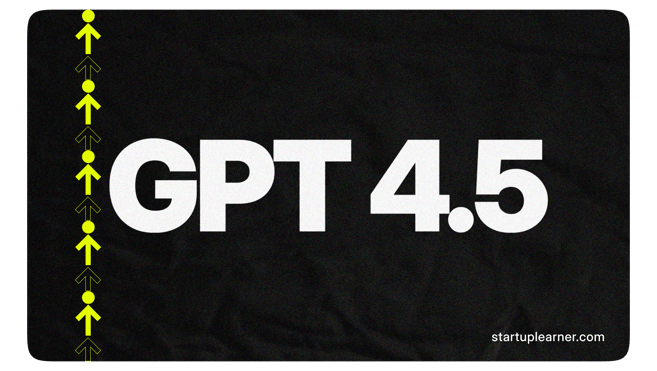GPT-4.5 and the Quiet Evolution of AI: Bridging Emotion, Creativity, and Intelligence
AI
Startup Learner
5/3/20253 min read



Introduction:
When GPT-4 arrived, it set a new bar for general-purpose intelligence. And ever since, the AI world has been holding its breath for what’s next. While GPT-5 remains elusive, OpenAI has unveiled GPT-4.5 — a model that might seem like a small step forward but actually signals a major shift in what AI is becoming: emotionally intelligent, creatively fluent, and increasingly human in its feel.
The Arrival of GPT-4.5: A Milestone in Emotional Intelligence
GPT-4.5 doesn’t scream innovation at first glance. There are no jaw-dropping breakthroughs in STEM reasoning or dramatic shifts in performance metrics. But take a closer look, and the model reveals its strength in something far more subtle: emotional depth, tone, and conversational grace.
OpenAI insiders describe GPT-4.5 as the company’s most humanlike model to date — not because it can solve a math problem better than GPT-4, but because it better understands what you mean when you ask a question. It's not just answering. It's connecting.
Scaling Up Quietly: A Bigger Model, Fewer Hallucinations
GPT-4.5 is OpenAI’s largest model yet — potentially more than 10x the size of GPT-4. But the size isn’t the headline. It’s what the model does with that scale.
Across key benchmarks:
Simple QA Accuracy: 4.5 hits 61.9%, a massive jump from GPT-4’s 38.4%.
Hallucination Rate: Down to 37%, from GPT-4’s 61.2%.
In practice, this means users get more reliable answers and less made-up nonsense — a quiet but critical upgrade in trust.
Where 4.5 Truly Shines: Creativity, Humor, and Persuasion
GPT-4.5 wasn’t built for math competitions. It was built to sound like someone you’d want to talk to. On benchmarks like “Make Me Pay” and “Make Me Say,” which test persuasive writing and emotional nuance, GPT-4.5 leaves GPT-4 and even GPT-4.0 Turbo behind.
It’s funnier. It’s more coherent. And in early private testing, it even seemed to understand irony — a notoriously difficult concept for AI. Users aren’t just noticing better performance — they’re feeling it.
That’s no accident. OpenAI’s team relied heavily on “vibe testing” for this model — subjective feedback from human evaluators about whether the response just feels better. That’s hard to quantify, but unmistakable in experience.
The Cost of Progress: 4.5 Isn’t for Everyone (Yet)
There’s a catch. GPT-4.5 is expensive — very expensive:
30x the cost of GPT-4 per input token.
15x the cost per output token.
This means it's currently impractical for large-scale deployment or businesses that rely on high-volume inference. For now, GPT-4.5 is more of a research and prototyping tool than a production model.
But as infrastructure improves and cost drops, models like 4.5 will become more accessible — and their qualitative leaps will be impossible to ignore.
What 4.5 Is Not: A Reasoning Powerhouse
Unlike OpenAI’s earlier model “01,” which was purpose-built for advanced reasoning, GPT-4.5 still lags in areas like:
Multi-step STEM problem solving
Advanced coding logic
Complex structured reasoning
That’s because GPT-4.5 is part of the unsupervised pre-training lineage — models that learn broadly from huge datasets, rather than being tuned specifically for logic-heavy tasks. It’s a master generalist, not a specialist.
The Bigger Picture: A Bridge to GPT-5
So why does GPT-4.5 matter?
Because it’s a signpost pointing toward convergence.
OpenAI’s researchers have suggested that the best future models won’t force a trade-off between reasoning and intuition. They’ll do both. The creative empathy of GPT-4.5 and the step-by-step logic of 01 could soon live in the same system.
Sam Altman hinted at exactly this:
“You could imagine a model that has the knowledge and the intuition of GPT-4.5, but combined with reasoning — that would be a really strong model.”
And that’s likely what GPT-5 will be — a hybrid that understands, plans, persuades, and reasons all at once.
Final Thoughts: The Age of Humanlike AI Is Quietly Arriving
GPT-4.5 won’t break the internet like ChatGPT did. But in many ways, it represents a deeper evolution. Not just in intelligence, but in feel.
It’s a model that listens better. Responds more naturally. Understands subtle cues. And creates in a voice that sounds — unmistakably — like ours.
As we look ahead to GPT-5 and beyond, it’s clear: the AI of the future won’t just think like us. It’ll relate to us.
And that might be the most transformative shift of all.



